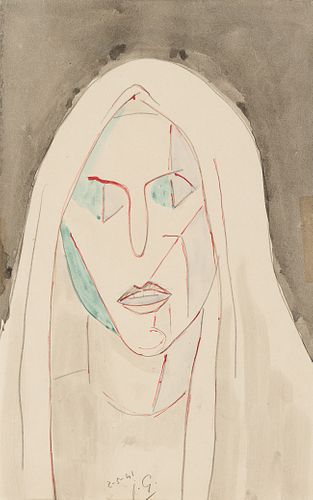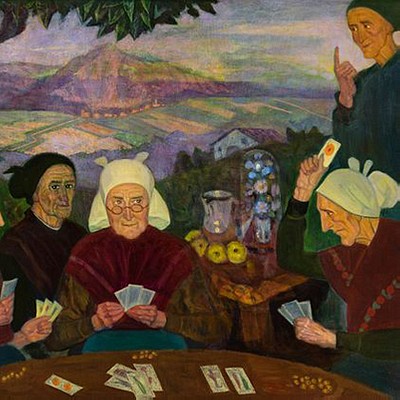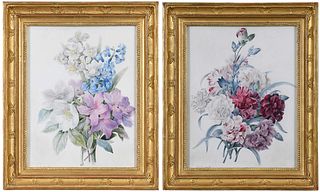JULIO GONZÁLEZ PELLICER (Barcelona, 1876 - Arcueil, France, 1942). "Smiling Virgin (study for a virgin", 1941. Crayon and watercolor on paper.
Lot 108
About Seller
Setdart Auction House
Carrer Aragó 346
Barcelona
Spain
Setdart Subastas was born in 2004 and is currently the first online art auction in Spain with solidity, prestige and reliability guaranteed by our more than 60,000 users. Setdart has a young, dynamic and enterprising team ready to successfully manage the purchase and sale of art works through custom...Read more
Categories
Estimate:
EUR€5,000 - EUR€6,000
$5,376.34 - $6,451.61
Absentee vs Live bid
Two ways to bid:
- Leave a max absentee bid and the platform will bid on your behalf up to your maximum bid during the live auction.
- Bid live during the auction and your bids will be submitted real-time to the auctioneer.
Bid Increments
| Price | Bid Increment |
|---|---|
| EUR€0 | EUR€10 |
| EUR€200 | EUR€25 |
| EUR€500 | EUR€50 |
| EUR€1,000 | EUR€100 |
| EUR€3,000 | EUR€200 |
| EUR€5,000 | EUR€500 |
| EUR€10,000 | EUR€1,000 |
| EUR€20,000 | EUR€2,000 |
| EUR€50,000 | EUR€5,000 |
About Auction
By Setdart Auction House
Dec 14, 2021
Set Reminder
2021-12-14 08:00:00
2021-12-14 08:00:00
America/New_York
Bidsquare
Bidsquare : 19th & 20th Century Fine Art
https://www.bidsquare.com/auctions/setdart-auction-house/19th-20th-century-fine-art-7992
Gaudi, Sorolla, Torres Garcia, Maclet, TSUGUHARU FOUJITA, Benjamin Palencia Setdart Auction House sofia@setdart.com
Gaudi, Sorolla, Torres Garcia, Maclet, TSUGUHARU FOUJITA, Benjamin Palencia Setdart Auction House sofia@setdart.com
- Lot Description
JULIO GONZÁLEZ PELLICER (Barcelona, 1876 - Arcueil, France, 1942). "Smiling Virgin (study for a virgin", 1941. Crayon and watercolor on paper. Presents label on the back of the Joan Prats Gallery (Barcelona). Work framed with museum glass. Signed and dated in the lower central area. Measurements: 31 x 19,7 cm; 59 x 48 cm (frame). -Work reproduced in: Julio González, itinerary of a dynasty. Vicente Aguilera Cerni. Ediciones Polígrafa 1973. Page 343, nº 533. -Provenance: Fernando Mignoni Collection, Julian Coca Collection. Considered the father of the sculpture in iron, Julio González is a key artist for the vanguard of the 20th century. He was born into a family of goldsmiths, learning the trade in modernist Barcelona. Later he studied Fine Arts at La Lonja in Barcelona. In 1900 he went to Paris, where he frequented the artistic environments and maintained contact with Picasso, Gargallo and Brancusi, among others, which would mark a before and after in his language. There he learned the technique of autogenous welding, key to his research with the expressiveness of iron. Around 1910 he began to work with embossed metal masks, with a style marked by naturalistic and symbolist features, and a new conception of the human figure, with synthesized volumes and lines. During these years, Gonzalez began to participate in the Parisian salons. In 1920 he opened his own forge workshop, and two years later he made his debut at the Povolovsky Gallery. During these years he experimented with the two-dimensionality of the plane, and continued in this line of exploration of volume until 1928, when he was asked to collaborate in the realization of the funerary monument of his friend Apollinaire, characterized by its transparent forms and its emptying. With Picasso, he puts his previous experiments into practice for the first time and proves their viability, given the perfect harmony between them and Picasso's synthetic capacity for drawing. Thus, the delicate small-format irons are finished, and his forms will be increasingly imposing and complex, pushing the artist internationally. Thus, at the end of the twenties he began his first sculptures in wrought iron. During the thirties his work became more abstract, and the first spatial constructions appeared. He prioritizes "the marriage between matter and space" and moves away from traditional symmetrical compositions, through what he himself called "drawing in space". These are improvised pieces, built directly with the wrought iron rod, which build schematic, abstract images of great formal complexity. In parallel, he will work with iron plate, creating a series of works that scholars have related to cubism. After a long list of participations in solo and group exhibitions such as Spanish Art at the Jeu de Paume Museum (1936) or the Universal Exhibition in Paris (1937), his work, as a result of the shortage of iron, focuses on a new material, gypsum, and on drawings with war themes. On the other hand, in 1937 he had achieved the culmination of his sculptural work in iron with "La Montserrat" and "Mujer ante el espejo". A key artist to understand the Spanish avant-garde, his work has been vindicated by important exhibitions such as the retrospective exhibition dedicated to him in 2009 at the MNCARS in Madrid. On the other hand, Gonzalez is represented in the most important contemporary art collections in the world, including the Georges Pompidou Center in Paris, the Reina Sofia in Madrid, the IVAM in Valencia and the MoMA in New York, among many others.
- Shipping Info
-
In-house shipping available. Please inquire at admin@setdart.com.
-
- Buyer's Premium



 EUR
EUR CAD
CAD AUD
AUD GBP
GBP MXN
MXN HKD
HKD CNY
CNY MYR
MYR SEK
SEK SGD
SGD CHF
CHF THB
THB
















